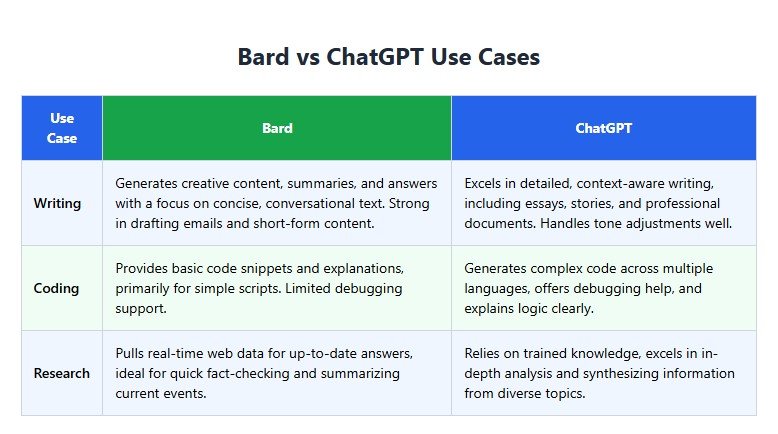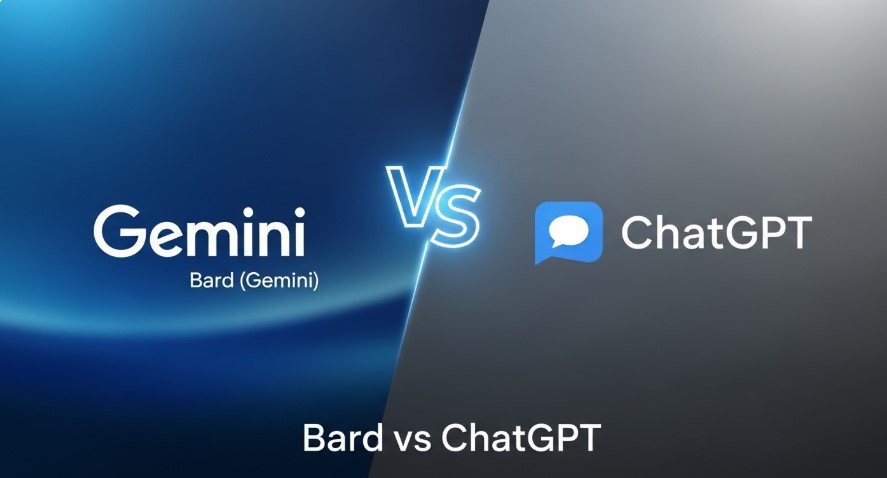AI chatbots are changing how we work, learn, and create. Google’s Bard (now Gemini) and OpenAI’s ChatGPT are two top players. But which is better in 2025? This post compares their features, performance, user experience, technical details, use cases, and limitations. All info is current as of July 2025.
Features and Capabilities
What Bard (Gemini) Offers
Bard, rebranded as Gemini in February 2024, uses Google’s Gemini Pro and Ultra models. It connects to the internet for real-time answers. Key features include:
- Live web data access for up-to-date responses
- Supports over 40 languages, including English and Spanish
- Integrates with Google tools like Maps and Docs
- Offers voice input, image generation, and text-to-speech
- Provides multiple response drafts for flexibility
What ChatGPT Offers
ChatGPT, powered by OpenAI’s GPT-4o (updated May 2024), excels in human-like text. Its features are:
- Supports over 95 languages, like English, Chinese, and Hindi
- Custom response options for paid users
- Image generation via DALL-E integration
- Voice mode on iOS and Android apps
- API for developers to integrate into apps
Bard shines with real-time data. ChatGPT leads in language support and customization.
Performance Comparison
Performance is key when choosing a chatbot. Here’s how they stack up:
- Accuracy: Bard’s internet access makes it ideal for recent events or trends. ChatGPT’s free version uses data up to October 2023, while the paid version reaches May 2024. Bard is better for current info, but ChatGPT’s paid version is close.
- Speed: Both respond quickly. Bard may slow slightly when pulling live data. ChatGPT’s GPT-4o is faster for complex tasks but lags in free mode (GPT-3.5).
- Consistency: ChatGPT delivers steady results across topics. Bard’s answers can vary due to web source quality.
Bard wins for real-time accuracy. ChatGPT is more consistent for general knowledge.
User Experience
A good chatbot feels easy to use. Here’s the breakdown:
- Bard: Offers a clean interface with voice input, image uploads, and multiple drafts. You can edit prompts after submitting and export to Google Docs or Gmail. Its text-to-speech reads answers aloud.
- ChatGPT: Features a simple text interface, with voice mode on mobile apps. Paid users can upload files or tweak responses. It’s less feature-rich but straightforward.
Bard’s extra options make it versatile. ChatGPT is simpler but effective for text-based tasks.
Technical Details
The tech behind each chatbot shapes its strengths:
- Bard: Runs on Gemini Pro and Ultra, trained on Infiniset (Common Crawl, Wikipedia, science papers, and code). Real-time web access keeps it current.
- ChatGPT: Uses GPT-4o, trained on a vast dataset of books, articles, and web content. Its context window is 128,000 tokens, smaller than Bard’s 1 million, which helps Bard handle longer conversations or documents.
Bard’s web access and larger context window suit research. ChatGPT’s training excels in text generation.

Real-World Use Cases
Both chatbots excel in practical tasks. Here’s where they shine:
- Writing: ChatGPT is great for articles, emails, or creative text. Its GPT-4o model produces detailed, human-like content. Bard can write too but adds real-time data for research-heavy tasks. See How to Use ChatGPT for UX Research for related tips.
- Coding: Bard’s access to current documentation gives it an edge for programming, like Flutter or Python. ChatGPT is strong but may lag on recent frameworks.
- Research: Bard’s real-time web access makes it better for market trends or news. ChatGPT suits deep dives into topics before 2024.
- Customer Support: ChatGPT handles FAQs and technical queries well. Bard excels in tasks like scheduling or pulling live data, such as stock updates.
ChatGPT is best for creative and detailed text. Bard leads in coding and research needing fresh data.
Limitations
No chatbot is perfect. Here are their downsides:
- Bard: Can give inconsistent answers if web sources vary. It supports fewer languages than ChatGPT. Ethical concerns, like biases, need monitoring.
- ChatGPT: Free version lacks post-2023 data. It can be verbose, slowing quick tasks. Privacy issues arise as inputs feed its learning.
Both have biases to watch. Bard’s web reliance and ChatGPT’s data cutoff are their biggest limits.
Answering Common Questions
From Google’s “People Also Ask” and “Related Searches,” here are key user questions:
Is Bard more accurate than ChatGPT?
Bard’s real-time data makes it better for recent events. ChatGPT’s paid version is accurate for older or detailed topics.
Which is better for coding?
Bard’s access to current docs gives it an edge, especially for refactoring. ChatGPT is solid but less up-to-date.
Can they handle creative tasks?
ChatGPT excels in writing poems or scripts. Bard adds real-time flair but is less creative.
Which is more private?
Bard is safer for sensitive data, as ChatGPT uses inputs for training.
Future Outlook
Both chatbots are evolving. Google plans tighter integration with its ecosystem, like Workspace. OpenAI is expanding ChatGPT’s API and custom GPTs. Expect improvements in accuracy and features by 2026.
Conclusion
Bard or ChatGPT? It depends on your needs. Pick Bard for real-time research, coding, or Google tool integration. Choose ChatGPT for creative writing, language variety, or detailed responses. Both are powerful, so test them for your tasks. For more AI insights, check ChatGPT vs InstructGPT or Aria vs ChatGPT on Technewscap.com.
